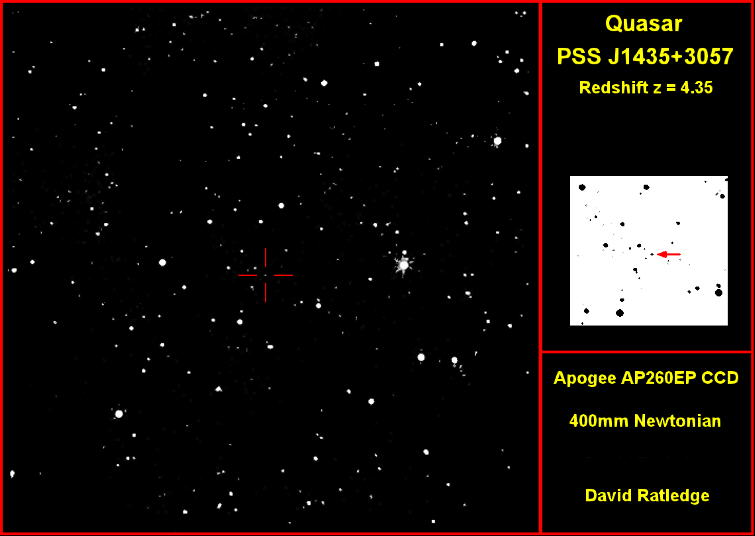
|
Imaging at the EdgeHigh Redshift QuasarsDavid Ratledge |
 |
IntroductionFor many astronomical objects the appearance is often disappointing. It is knowing what that fuzzy patch represents that makes it interesting. Such is the case with quasars – they are only ever going to be small points of light so it is knowing their huge distances that warrants searching them out. And with the large redshift quasars we are seeing back almost to the dawn of time. We are viewing something more than twice as old as the Solar System.
|
|
The first quasars to be discovered were mistaken for blue stars with strange spectra. At rest their emission peaks in the ultra-violet. However, in the case of high redshift (z>4) quasars then that peak emission gets shifted into the red and near infra-red. This is just the wavelength to which amateur CCD cameras are most sensitive. Quasars near the edge of the Universe are therefore well within our reach. We will only record them as dots – but dots of such significance as they are some of the oldest objects known in the Universe –their light has been travelling towards us for around 12 billion years.
On the right we compare the spectral energy distribution (SED) of a high redshift quasar and a realtively nearby galaxy with an active galactic nuclei (AGN), the Seyfert galaxy NGC4151. If the SED of NGC4151 is shifted 6 times (ie if it had a redshift of 5) then it matches that of the Quasar at z=5 almost perfectly. Note also that the peak energy is the Lyman Alpha line in the ultra violet which when redshifted ends up in the near infra red- just where our cameras are most sensitive. |
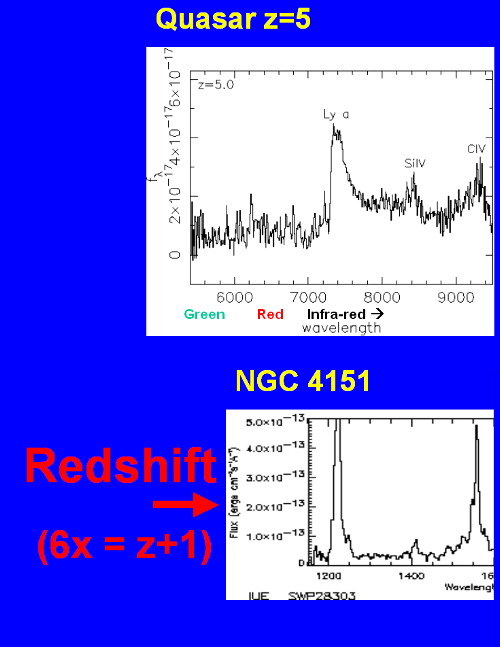 |
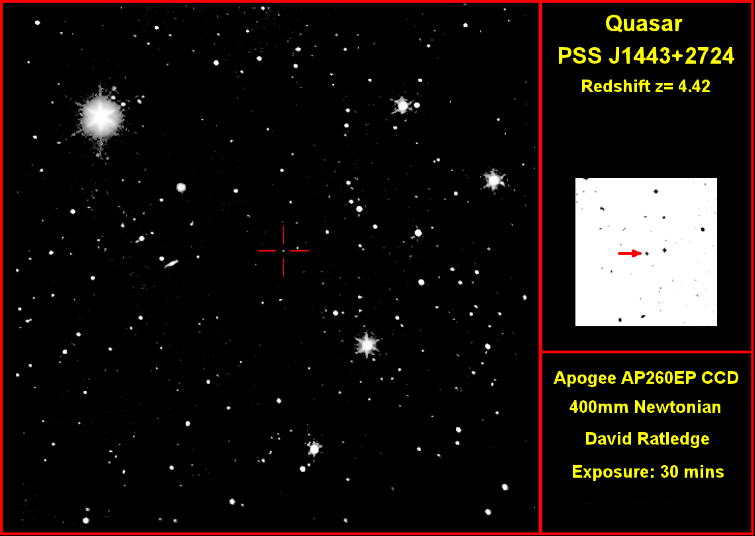 |
ImagingSo how do we track these objects down and then successfully image them? Taking the second one first. The secret to imaging them is a CCD camera without an infra-red block filter. A big light bucket telescope helps as we will recording at around magnitude 21 in the infra-red – less in the visible. I found I could reach this magnitude with around 1 hours worth of total exposure . The brighter quasars (z<5) then 30 minutes is sufficient. An infra-red pass filter or deep red filter boosts contrast - these images here were shot with an infra-red pass filter. |
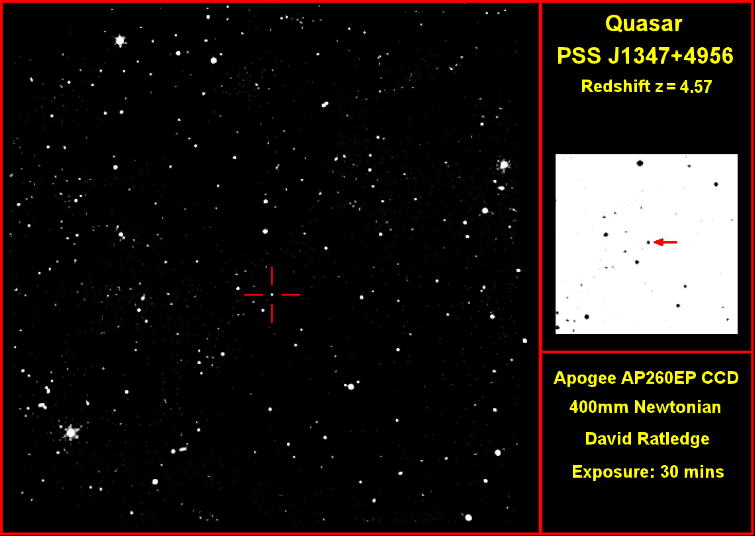 |
Data SourcesAs regards tracking these objects down then life is quite tricky. One of the primary discover of high redshift quasars has been the Sloan Digital Sky Survey (SDSS). Trawling through the publications based on this survey is probably the best course of action. One source is available here. These quasars are referred to by their coordinates so it would seem straight forward to image them – we have after all the RA and DEC in their name!
|
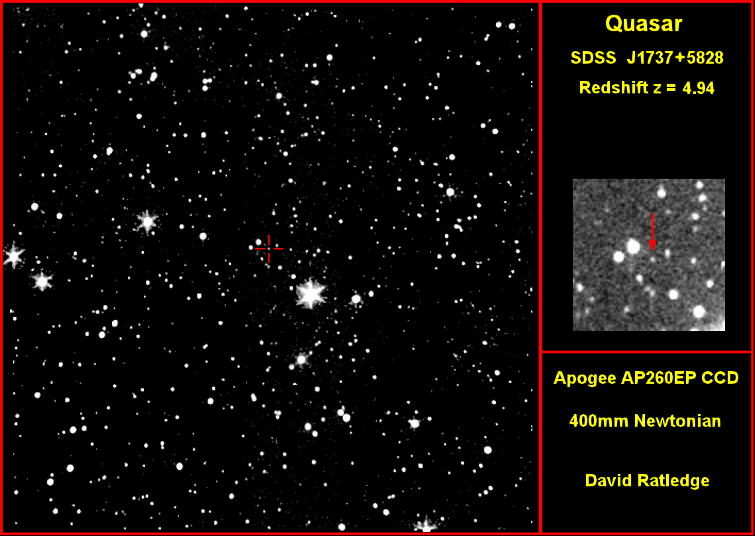 |
Finder ChartsWhat of course we need is not just a list of objects – there are plenty of those around – but finder charts. Without finder charts, shooting at the coordinates given will result in many point like objects but identifying the right one is virtually impossible. Only when finder charts are published do we have a chance. Even so the finder charts often have very narrow fields of view and working out its exact position on the sky is still difficult. It can be done however and is well worth the effort. If only professionals always published finder charts but I guess they would never realise that amateurs might want to search them out!
|
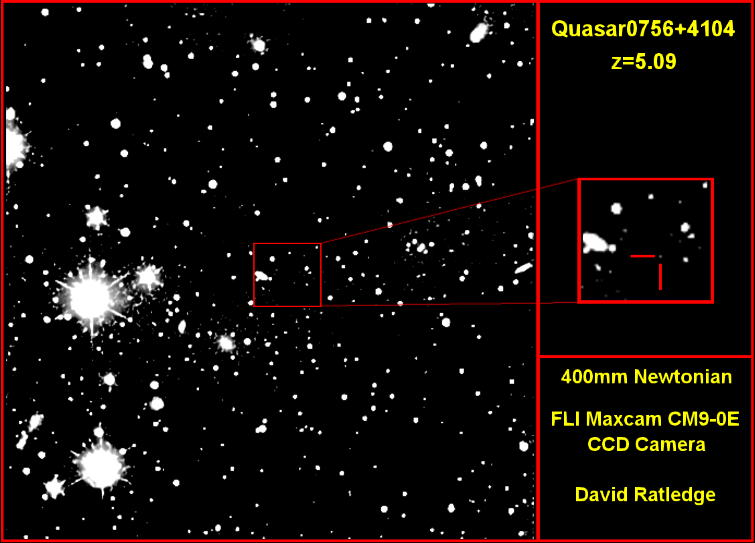 |
FootnoteI have used the term redshift and light travel time in this webpage. Popular magazines (at least in the UK) will avoid this - presumably assuming it is much to complex for amateur astronomers to understand. Instead they will erroneously describe these objects as being 12.25 to 12.5 billion light years distance. Nothing could be further from the truth! Their current distance from us is around 26 billion light years – what they mean, of course, is light travel time. Paradoxically these high redshift objects were relatively close to use when their light set out on its journey to Lancashire – the expansion of the Universe has reddened their light and carried them to such huge distances. To calculate light travel time and current distance I recommend Ned Wright's web page: click here You have to enter light travel time and the answers then come out (press the General button) - you have therefore to iterate to the correct redshift z. Note the very strange result for the angular size distance! They appear bigger (therefore nearer) than simple geometry would predict. |
If you enjoyed this adventure then check out the Infra-Red imaging section as well.
